This post may contain affiliate links. For more information about my affiliate disclosure, please click here
Did you know that 70% of U.S. households own a pet, with dogs being the most popular choice? It’s no surprise, considering the joy and companionship they bring to our lives.
As a parent, you may wonder which breed would be the perfect addition to your family, especially if you have young children.
Well, look no further!
In this article, we’ll guide you through some of the best dog breeds for kids known for their patience, loyalty, and gentle nature.
Choosing the ideal canine companion requires careful consideration of various factors, such as your home environment and lifestyle. The right match can foster a loving relationship between your kids and their furry friend while teaching them important lessons about responsibility and empathy.
- On-Demand Videos
- 24/7 Support
- Improves Dog’s Mental Health
- Improves Dog’s Mental Illness
- Dog Training Tricks and Games to Improve Dog’s Response
- In-depth Video Training
- Available on All Devices
- Includes One Time Fee
Whether it’s an affectionate Cavalier King Charles Spaniel or a protective Newfoundland, there are several breeds suited to families with children. So let’s dive in together to explore these wonderful dog breeds that could become the newest member of your family!
Table of Contents
Key Takeaways
- Research suitable dog breeds based on home and lifestyle before adoption.
- Staff at shelters or rescue agencies can help point towards pets that will be a good fit.
- Consistent, positivity-focused training is important for new pets.
- Adopting a mixed-breed dog gives them a forever home and frees up a spot in a shelter.
Why Dogs Are Perfect Partners for Your Kids

You’ll find that dogs are indeed a kid’s best friend, as their loyal and loving nature can transform your home into a lively playground filled with wagging tails and endless laughter.
Why dogs are beneficial for kids goes beyond the fun they provide; they also play an essential role in child development. Dogs teach children about responsibility, empathy, and the value of nurturing relationships through caring for another living being.
Tips for introducing a new dog to a family with kids start with research on how to choose the best dog breed for your family. Consider factors like size, energy level, temperament, and grooming needs before deciding.
- Consult with experts or shelter staff who can help you find a good match based on your specific situation. The benefits of adopting a shelter dog for your family include giving an animal in need a loving home while teaching children about compassion and the importance of helping others.
As you embark on this journey to welcome a furry companion into your family, remember that timing is crucial when introducing pets and young children.
Be prepared to invest time and effort into proper training so that both kids and dogs understand boundaries and expectations from each other.
This will ensure harmony within the household while fostering strong bonds between all members – human and canine alike!
Keep reading to learn more about when it might be too early to adopt a dog for kids so you can make informed decisions in balancing everyone’s needs within the family unit.
When its too Early to Adopt Dog for Kids
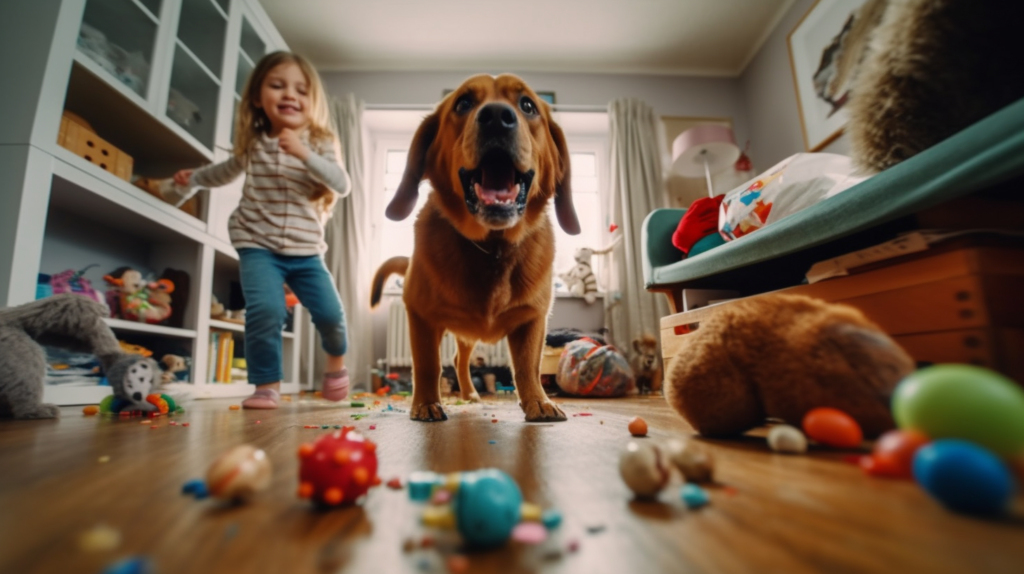
It’s essential to consider the right time for adopting a furry friend, as introducing one too early in a child’s life may not always be ideal. When to wait largely depends on your child’s age, maturity level, and ability to handle the responsibilities that come with owning a pet.
Benefits of waiting include ensuring your child is ready to take on the commitment of caring for an animal and understanding the importance of training, exercise, and proper nutrition for their new companion.
In the meantime, there are alternative options you can explore while preparing for the future addition of a four-legged family member.
- For instance, you could arrange visits to friends or relatives who own dogs so your child can learn how to interact with them safely and confidently. Setting expectations by discussing what it means to have a dog in the family will help establish boundaries and responsibilities before bringing one home.
- Additionally, spending time volunteering at animal shelters can be both educational and rewarding for children eager to connect with animals.
As you continue researching suitable breeds and considering when it might be appropriate to introduce a dog into your family dynamic, don’t forget about older dogs!
They often make great companions for kids because they’re generally more patient and laid-back compared to puppies. Plus, shelter staff members can help match you with an older dog whose temperament suits your family best.
Keep this option in mind as you navigate the exciting journey towards finding the perfect canine companion for your growing family.
Older Dogs and Children
Don’t overlook the benefits of adopting an older dog for your family, as they’re often more patient and laid-back, making them a wonderful fit for households with children. Many people have common misconceptions about dogs and children, thinking that only puppies can form strong bonds with kids. However, older dogs come with their own unique advantages that make them perfect companions for little ones.
- Benefits of adopting older dogs: Older dogs are typically calmer and more settled than young puppies, which means they’re less likely to accidentally knock over or overwhelm small children. They usually have some basic training under their belts already, so you won’t need to start from scratch teaching them manners.
- Tips for introducing dogs to children: To ensure a smooth transition when bringing an older dog into your home, introduce them gradually to your kids and supervise interactions closely at first. Teach your children how to approach the dog respectfully and gently, allowing the dog time to adjust as well.
- Activities to do with dogs and kids: There are countless fun activities you can do together as a family once the initial introduction period is over – think gentle games of fetch, leisurely walks in the park or even just snuggling up together on the couch.
Finding the right dog for your family might take some time and research but remember that age shouldn’t be a limiting factor when it comes to adoption. Staff at shelters or rescue agencies can help point you towards pets that will be a good fit for both your lifestyle and your child’s temperament. Plus, by giving an older canine companion a loving forever home, you’ll be serving others by freeing up space in shelters for other animals in need.
As important as it is to find the perfect furry friend for your family, uniting kids and dogs creates endless opportunities for bonding experiences while teaching valuable life lessons like responsibility, empathy, teamwork, among others. One crucial aspect not to overlook though is ensuring the new pet receives consistent, positivity-focused training that lays the foundation for a harmonious home dynamic. This paves the way for the next topic: the importance of dog training for kids.
Importance of Dog Training For Kids
Training your new canine companion is essential for creating a harmonious family environment, and involving your kids in the process can be both educational and rewarding.
The importance of dog training for kids goes beyond simply teaching them how to interact with their pets; it also helps them develop crucial life skills such as responsibility, empathy, trust, communication, and physical activity.
By engaging your children in the training process, you’re not only setting up a strong foundation for a lasting bond between them and their furry friend but also fostering their growth as responsible pet owners and compassionate individuals.
Involving your kids in dog training teaches responsibility by giving them specific tasks related to caring for their pet. They’ll learn firsthand about the commitment required to maintain a healthy relationship with their canine pal through consistent feeding schedules, regular grooming sessions, exercise routines, and more.
Additionally, participating in training sessions helps develop empathy as they begin to understand their dog’s emotions better – recognizing when they’re happy or stressed – which ultimately strengthens the connection between child and pet.
Building trust with a new dog is vital for both children and adults alike. As your kids actively engage in training sessions using positive reinforcement techniques – like praise or treats – they’ll enhance communication with their four-legged buddy while also encouraging physical activity.
This combination of mental stimulation and exercise will help keep everyone happy, healthy, and engaged within your household. So go ahead, involve those little ones in every aspect of bringing home a new best friend!
Up next on our list of best family dogs that are good with kids is none other than the affectionate boxer.
Boxer
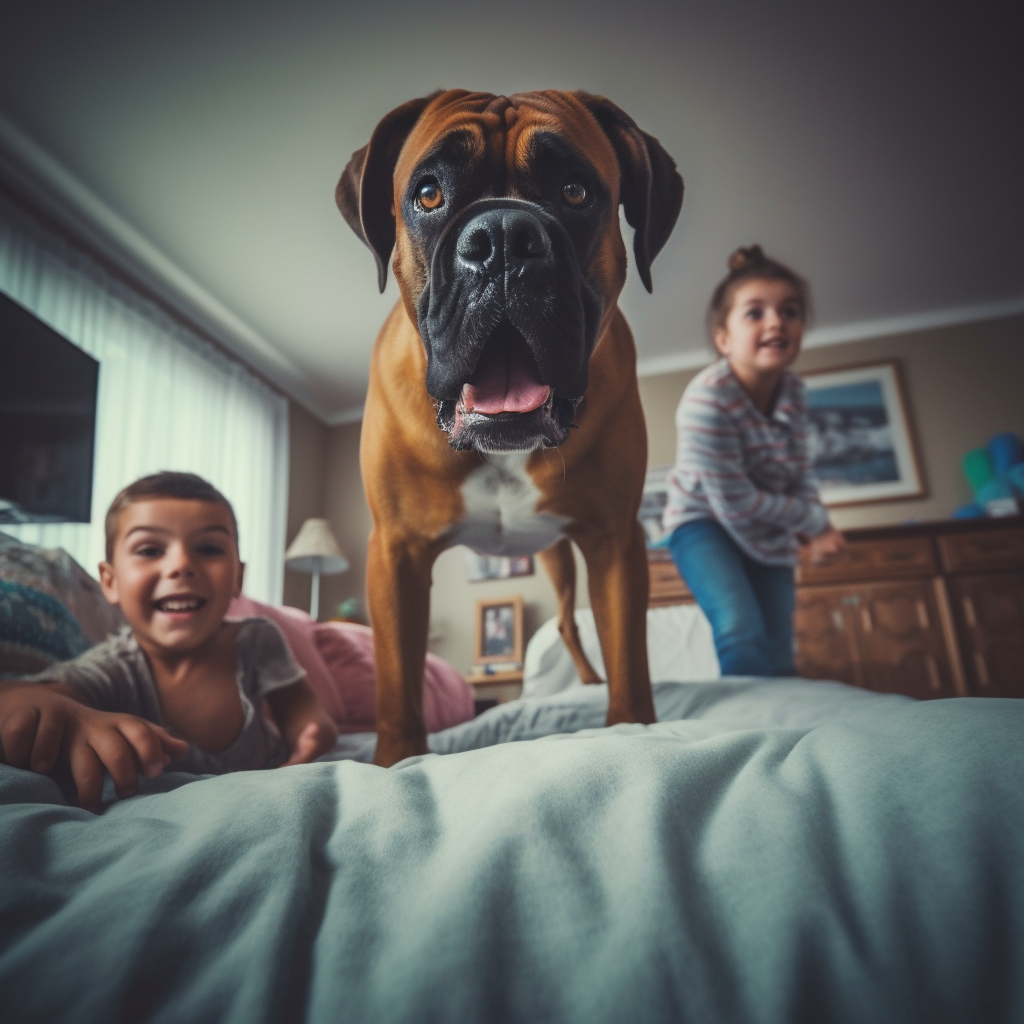
You’ll find that boxers are a loving and energetic breed, perfect for families with children who enjoy active playtime and lots of affection. Known for their playful and patient temperament, boxers make great companions for kids as they’re protective yet gentle with their family members. As a highly intelligent breed, they thrive when given consistent training focused on positivity and rewards.
- Boxer Temperament: playful, patient, and protective
- Boxer exercise needs: daily walks and active playtime
- Boxer health concerns: prone to certain conditions like hip dysplasia and heart issues
To ensure your boxer remains happy and healthy within your family dynamic, it’s important to address their exercise needs through daily walks and engaging activities that stimulate both their body and mind.
Additionally, be aware of potential health concerns such as hip dysplasia and heart issues; regular check-ups with your veterinarian can help monitor these conditions.
When it comes to training tips for your boxer, using positive reinforcement techniques will yield the best results in teaching them obedience skills while fostering a strong bond between you two. In fact, some boxers have even been known to excel as therapy dogs due to their empathetic nature.
As you consider adding a boxer to your family, keep in mind that this loyal companion is just one option among many fantastic breeds suitable for kids. For example, another popular choice is the German Shepherd – known for its intelligence, loyalty, and versatility in various roles from family pet to working dog capacities.
German Shepherd
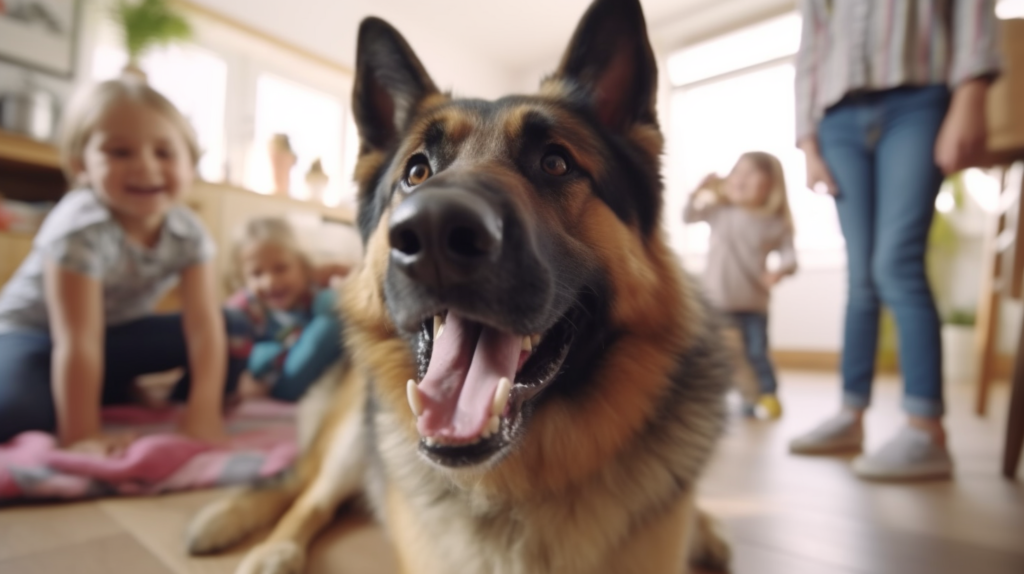
German Shepherds are an incredibly versatile and intelligent breed, making them well-suited for families with children who appreciate loyalty and adaptability in their canine companions. They are often used as police dogs and service animals.
German Shepherds respond well to consistent, positive-focused training that emphasizes building trust and understanding between dog and owner. With the proper guidance from you, a German Shepherd can be taught to perform various tasks around the house, engage in family activities, and even help keep your kids safe by acting as a watchful guardian.
As active working dogs, German Shepherds require regular physical activity to stay healthy and happy. Daily walks or runs are essential for meeting their exercise needs. Playing fetch or engaging in other outdoor games can also provide mental stimulation they crave.
It’s important to address any potential behavioral issues early on through proper training techniques. Regular grooming is necessary for this breed due to their double coat, which sheds seasonally. Brushing your German Shepherd several times a week will help minimize shedding while keeping its coat healthy.
Health concerns common among German Shepherds include hip dysplasia, allergies, degenerative myelopathy (a neurological disorder), and bloat. Staying proactive with veterinary check-ups will help you ensure your furry friend stays in tip-top shape.
Transitioning from an energetic powerhouse like the German Shepherd might seem surprising when considering the Cavalier King Charles Spaniel as another option for family-friendly dog breeds.
However, these smaller companions offer just as much love and commitment to their families while bringing a calmer demeanor perfectly suited for those seeking a more easy-going household pet.
Next up: exploring the delightful traits of the charming Cavalier King Charles Spaniel!
Cavalier King Charles Spaniel
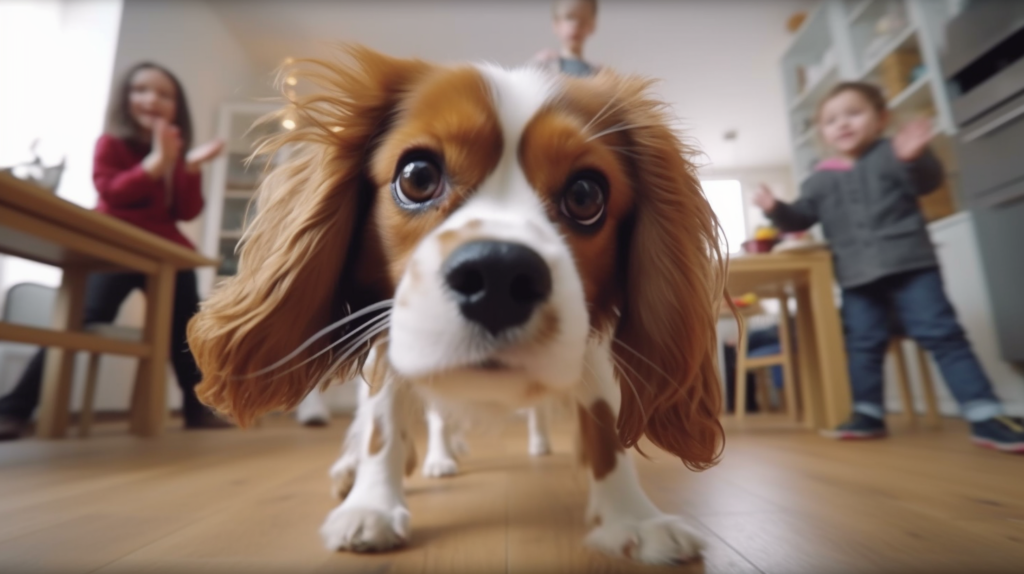
While German Shepherds can be great family pets, another breed to consider for your family is the Cavalier King Charles Spaniel. Known for their calm and easy-going temperament traits, these adorable dogs are incredibly friendly and get along well with everyone, including children.
Their small size makes them less intimidating for young kids but still provides enough energy and playfulness to keep up with an active household. When it comes to health concerns, Cavaliers are generally healthy dogs; however, they may be prone to certain issues such as heart problems or hip dysplasia.
Regular veterinarian check-ups will help you catch any potential issues early on. Training requirements for this breed are relatively minimal since they’re eager to please and quick learners. Positive reinforcement-based training methods work best with Cavaliers, as they respond well to praise and treats.
Exercise needs for this breed include daily walks and playtime sessions that engage both their body and mind. And when it comes to grooming tips, brushing your Cavalier’s coat regularly will keep it tangle-free while helping reduce shedding.
One more family-friendly dog breed worth exploring is the Bernese Mountain Dog – a gentle giant known for its warm-hearted nature that pairs well with families of all sizes.
These lovable dogs have a patient demeanor that makes them fantastic companions not only for kids but also adults seeking a low-key buddy who loves cuddling as much as playing outdoors together!
Bernese Mountain Dog
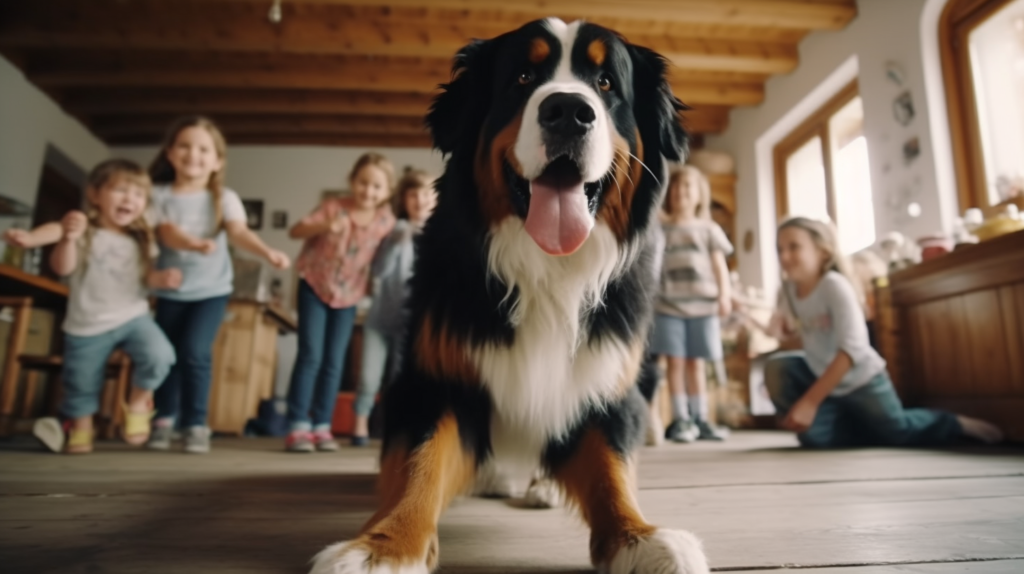
If you’re seeking a gentle giant to join your family, look no further than the Bernese Mountain Dog – known for their warm-hearted nature and patience with children of all ages. These dogs are well-suited for cold weather climates, originally bred as working dogs on Swiss family farms.
With their strong build, affectionate demeanour, and protective instincts, they make excellent companions for families looking for a loving addition that can also serve as a watchful guardian.
Bernese Mountain Dogs have found their calling in various roles outside of the traditional farm setting. Their calm and kind disposition makes them exceptional therapy dogs, offering comfort and support to those in need.
If you’re considering adopting one but would like a bit more variety in size or appearance, don’t worry – there are plenty of Bernese Mountain Dog mixes available that showcase these wonderful traits while presenting unique physical characteristics.
But before you make up your mind about bringing home this lovable breed, it’s essential to consider the time and commitment required to raise such a large dog. Regular exercise is vital to keep them happy and healthy; grooming their thick coat is also necessary to prevent matting and maintain cleanliness.
As you explore your options for the perfect family pet, remember that an Alaskan Malamute might be another fantastic choice if you’re searching for an active breed with unwavering loyalty and love towards its human pack members.
Alaskan Malamute

After learning about the warmth and gentleness of the Bernese Mountain Dog, you might also consider an Alaskan Malamute for your family. These powerful dogs were originally bred for work as sled dogs, so they have a strong and athletic build.
However, their temperament and behavior make them fantastic companions for families with children who are eager to embrace this breed’s training requirements and exercise needs.
Alaskan Malamutes need consistent training using positive reinforcement techniques, as they can be quite independent-minded. With patience and consistency, these intelligent dogs will become well-behaved members of your household. Exercise is key for this active breed; daily walks or hikes will help keep them physically fit while promoting a happy disposition.
Best Paw-Shaped Dog Bed in 2023 : Find the Perfect Comfort for Your Furry Friend
Grooming-wise, regular brushing will help manage their thick double coat and minimize shedding indoors. Health concerns to watch out for in this breed include hip dysplasia and eye issues; regular check-ups with your veterinarian can ensure that any potential problems are addressed early on.
True to their working heritage, Alaskan Malamutes have a loyal and friendly temperament which makes them excellent playmates for kids when properly trained. Their high energy levels require an active lifestyle but reward you with an affectionate bond that lasts a lifetime.
As you continue exploring different breeds suitable for your family, don’t miss out on the charming Boston Terrier – another great option that not only thrives in apartment living but also enjoys being the center of attention among its humans!
Boston Terrier
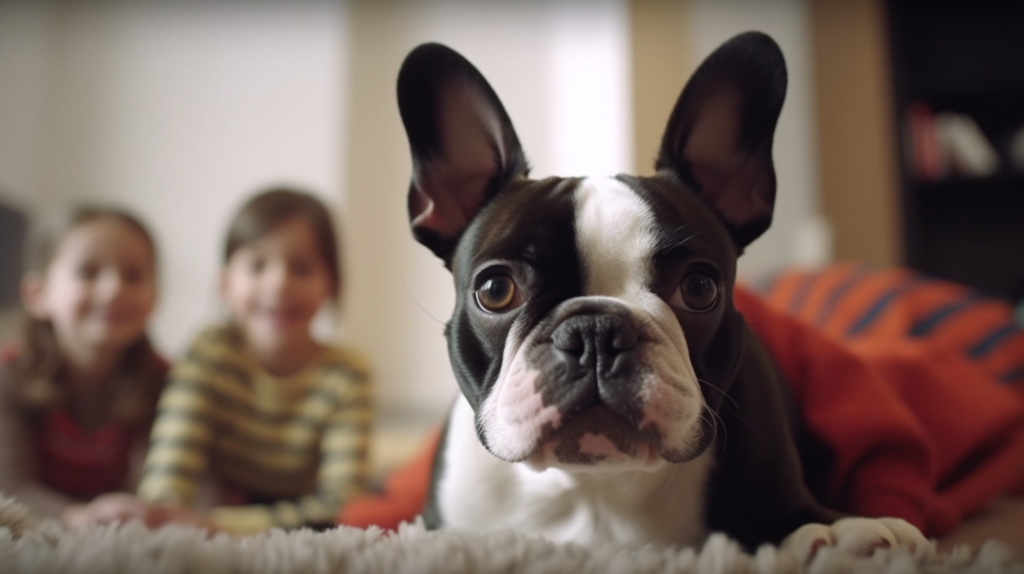
You’ll be over the moon with a Boston Terrier as part of your family, as these people-oriented pups adapt well to apartment living and love being the center of attention. Known for their distinctive tuxedo-like markings, Boston Terriers are affectionate and intelligent dogs that make great companions for both kids and adults.
Despite their small size, they have a lively temperament and will happily engage in playtime or cuddle up on the couch with you.
When it comes to exercise needs, Boston Terriers don’t require an excessive amount but do enjoy daily walks and play sessions to keep them physically fit and mentally stimulated.
Their grooming requirements are relatively low-maintenance; regular brushing will help keep their short coat looking sleek, while occasional baths will ensure they stay clean and fresh-smelling. Training tips for this breed include using positive reinforcement techniques, as Boston Terriers respond well to praise and rewards.
One important thing to remember about the lovable Boston Terrier is that they can be prone to certain health issues such as respiratory problems due to their short snouts – so be mindful of not over-exerting them during exercise or exposing them to extreme temperatures. With proper care and attention, a Boston Terrier can make a fantastic addition to any household – especially one with children who appreciate a playful pup!
Now if you’re looking for another dog breed that’s known for its friendly nature towards kids, let’s explore what makes Labrador Retrievers such wonderful family pets.
Labrador Retriever
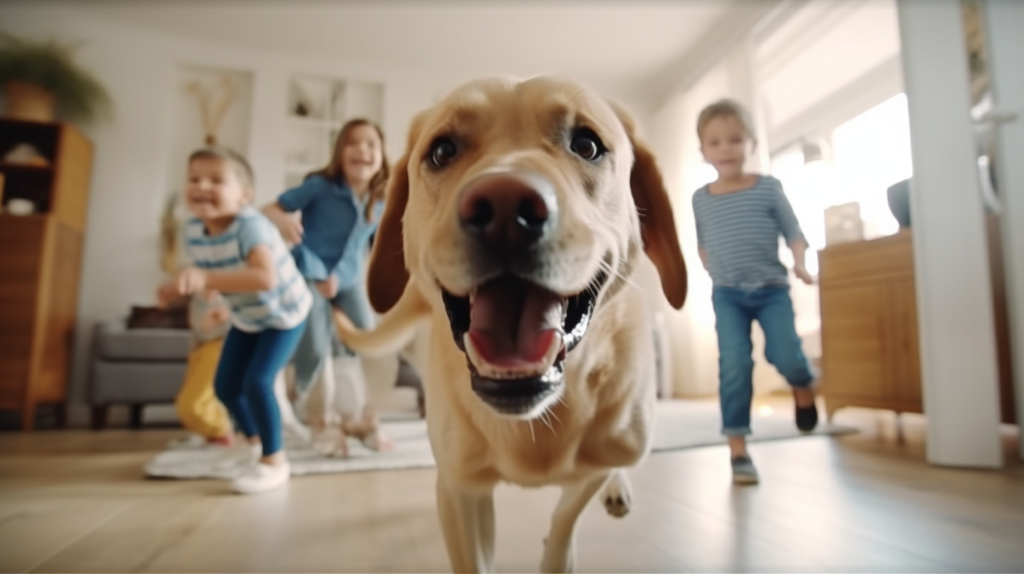
There’s no denying that Labrador Retrievers have captured the hearts of countless families, with their lovable nature and unwavering loyalty making them a perfect addition to homes with children. However, it’s essential to understand the unique needs of this breed before bringing one into your home.
Exercising Labrador Retrievers is crucial, as they’re highly energetic dogs that require daily physical activity to maintain their health and happiness. Training Labrador Retrievers is also an important aspect of owning this breed, as their intelligence and eagerness to learn make them excellent candidates for obedience training and even more advanced skills.
One thing to consider when adopting a Labrador Retriever is whether or not someone in your household has allergies, as these dogs do shed quite a bit. If shedding is a concern but you’re still drawn to this wonderful breed, researching Labradoodle or other low-shedding mixes might be an option for you.
Additionally, while many people successfully raise Labs in apartments or smaller living spaces, it’s crucial to ensure that your dog gets plenty of exercise despite limited room at home. This may mean frequent trips to the park or doggy daycare during the day.
Caring for senior Labrador Retrievers involves paying close attention to their changing needs as they age. Regular vet checkups become increasingly important as older dogs may develop age-related health issues such as arthritis or hip dysplasia, which can affect their mobility and overall quality of life. Be prepared to adapt your dog’s environment and routine accordingly as he ages gracefully by your side.
As you explore the world of family-friendly dog breeds further, you’ll soon discover another fan-favorite: The Golden Retriever – known for its affectionate nature and boundless energy!
Golden Retriever
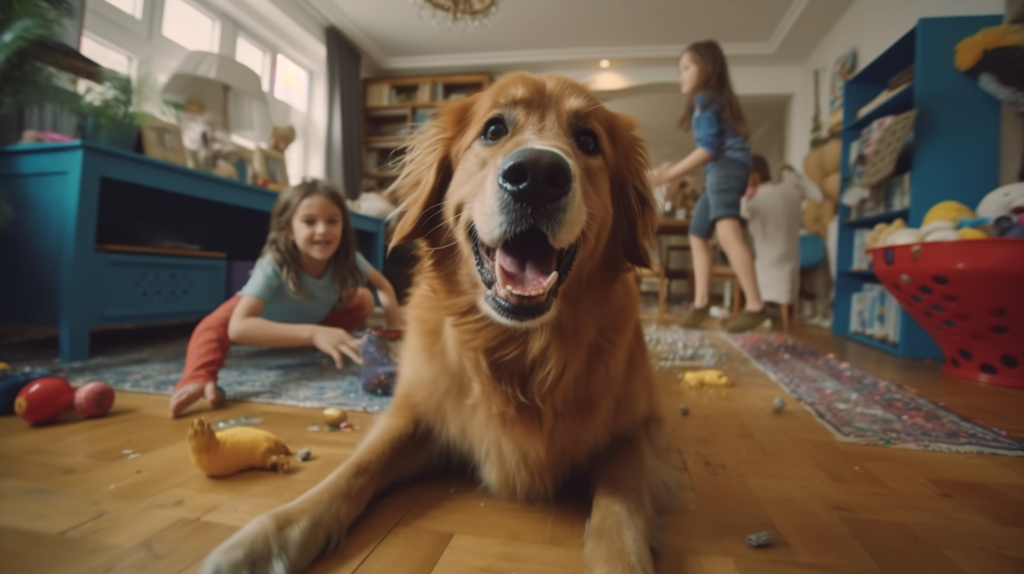
If you’re looking for a canine companion that’s both affectionate and energetic, the Golden Retriever is an excellent choice, especially for families with children.
For instance, imagine spending sunny afternoons at the park playing fetch with your furry friend, watching as they tirelessly run back and forth while your kids giggle in delight.
This breed’s friendly nature also makes them great therapy dogs; their gentle demeanor and keen intelligence make them easy to train for obedience, socialization techniques, and even assistance roles in various settings.
To keep your Golden Retriever happy and healthy, it’s important to establish regular exercise routines that cater to their high energy levels. Long walks or hikes are perfect activities to engage in together as a family. Additionally, incorporating games like fetch or swimming will help channel their natural retrieving instincts in a fun way.
Alongside physical activity, grooming tips are essential for maintaining the health of their beautiful coat; frequent brushing helps prevent matting and keeps shedding under control.
As you consider adding a Golden Retriever to your family roster of lovable companions, remember that proper training and socialization from an early age can ensure they grow into well-behaved members of your household. With consistent efforts put into exercise routines and grooming practices, these loving dogs can truly thrive as beloved additions to any home environment.
Now let’s take a look at another breed known for its loyalty and laid-back demeanor – the charming Bulldog!
Bulldog
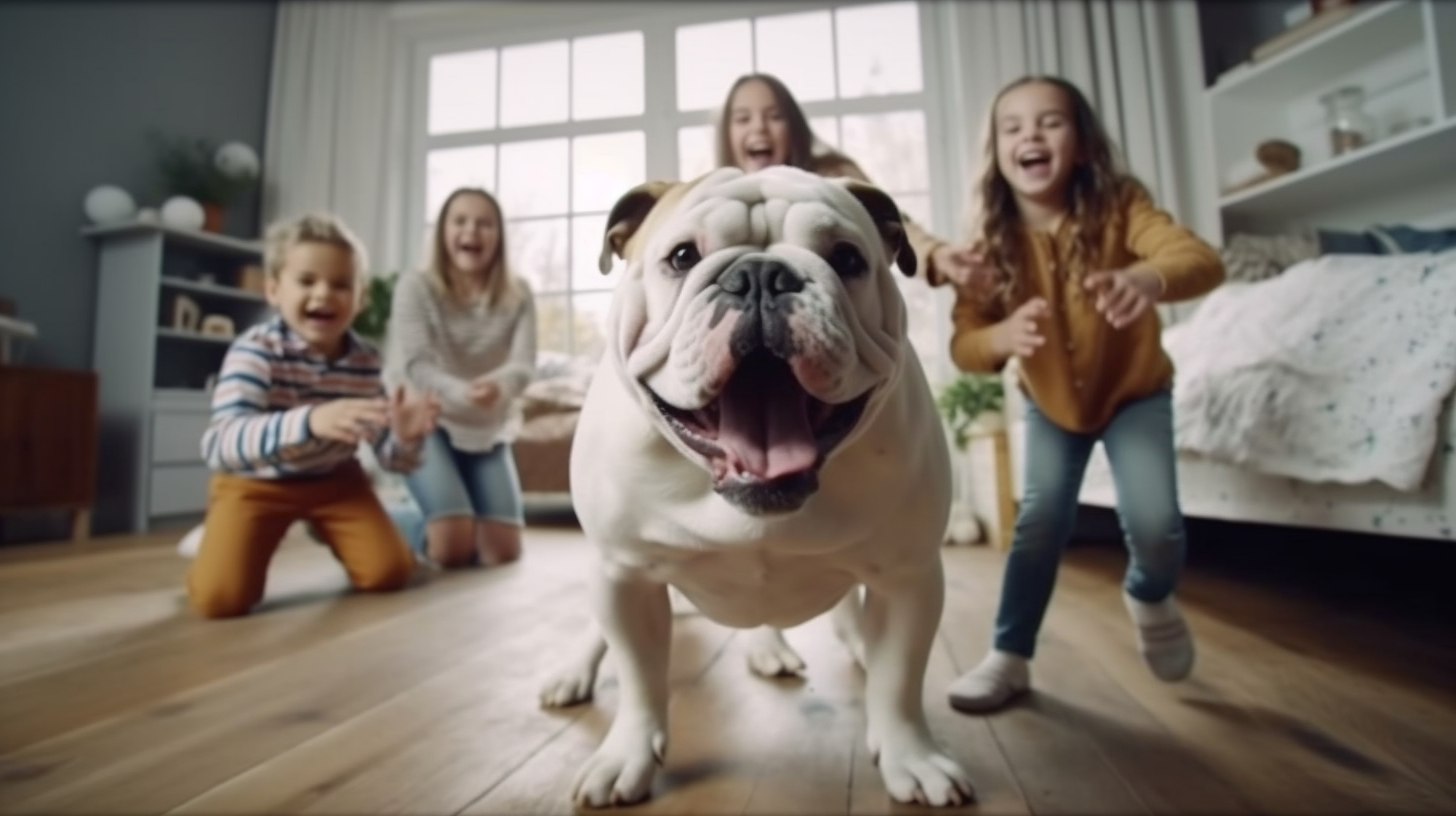
Bulldogs are known for their loyalty and laid-back nature, making them a delightful addition to any family seeking a loving canine companion. One of the benefits of owning a bulldog is that they have relatively low energy levels, so they’re content with short walks and lots of snuggling on the couch.
They also tend to be patient with children and get along well with other pets in the home. Moreover, bulldogs can make excellent therapy dogs due to their calm demeanor and strong bond with their human companions.
Training tips for bulldogs and kids: Bulldogs are intelligent but can be stubborn at times, so it’s essential to start training early using positive reinforcement methods like praise and treats.
Health concerns for bulldogs: Bulldogs are prone to certain health issues such as hip dysplasia, respiratory problems, skin allergies, and overheating; regular vet check-ups can help catch any potential problems before they become more serious.
Finding the right bulldog for your family: Visit shelters or rescue groups specializing in bulldogs or go through reputable breeders who prioritize health screenings and temperament testing.
With proper care and attention, a healthy relationship between your children and your new furry friend will flourish over time. Remember that consistent training paired with love will create an environment where both your kids and your bulldog feel secure, happy, and loved.
Now that you know more about what makes bulldogs great family pets, let’s move on to another small yet mighty breed – the pug!
Pug

Pugs, with their wrinkly faces and expressive eyes, have a unique charm that’s hard to resist – especially for families seeking a small yet affectionate canine companion. These lovable couch potatoes are known for their easy-going nature and adaptability to various living situations, making them an excellent choice for households with children.
However, it’s essential to understand the Pug exercise needs, grooming requirements, health concerns, socialization tips, and training techniques before bringing one home.
To keep your Pug healthy and happy, regular exercise is necessary despite their preference for lounging around. Short walks or play sessions in the yard should suffice – just be mindful of hot weather as they can overheat easily due to their short snouts.
Grooming-wise, Pugs shed quite a bit; brushing them regularly will help manage shedding and keep their coat healthy. Additionally, pay special attention to cleaning the folds in their face to avoid infections or irritations.
When it comes to training your Pug, positive reinforcement techniques work best since they’re sensitive souls who respond well to praise and treats.
Socializing your Pug early on is crucial as they tend to be friendly by nature but can become timid or aggressive if not properly exposed to different people and animals from a young age. Encourage gentle play with kids and other pets under supervision so that everyone learns how to interact appropriately together.
With proper care and attention towards exercise needs, grooming requirements, health concerns like overheating or eye issues specific in this breed along with consistent socialization practices – you’ll have a loving family pet eager for snuggles at the end of every day.
Next up on our list of best dog breeds for kids: meet the adorable Beagle!
Beagle

You’ll find it hard to resist the charm of a Beagle, with their floppy ears and big, soulful eyes that seem to have an endless supply of love for everyone in the family. These cute and friendly dogs thrive on companionship, making them great playmates for children.
However, there are some pros and cons of Beagle ownership that you should consider before bringing one into your home.
For example, while Beagles are generally good-natured and easygoing, they can be stubborn regarding training. To ensure a harmonious relationship between your Beagle and your kids, start early with positive reinforcement techniques when teaching them how to get along with children.
There’s no doubt that Beagles love being active, so finding recommended activities for both your new pup and your kids is essential. Your children will enjoy playing fetch or long walks with their furry friend since these energetic dogs need plenty of exercises.
In addition to keeping them physically fit, engaging in regular outdoor activities will help keep boredom at bay – which can sometimes lead to destructive behaviour in this breed.
When it comes to grooming tips for maintaining a healthy coat, regular brushing is important as well as occasional baths – just be careful not to overdo it! Some health concerns you may want to watch out for include hip dysplasia and ear infections due to their floppy ears.
Beagles can make wonderful additions to families with children thanks in part due to their loving nature and enthusiasm for playtime. Just remember that consistency in training is key when teaching them how best to interact with little ones in a safe manner. With proper care including grooming routines aimed at preventing potential health issues like ear infections or hip problems from developing further down the line, there’s no reason why this lovable breed couldn’t become an integral member of any household looking forward to welcoming man’s best friend into its fold!
Next up on our list – the showstopping Irish Setter, another fantastic breed for families with kids.
Irish Setter
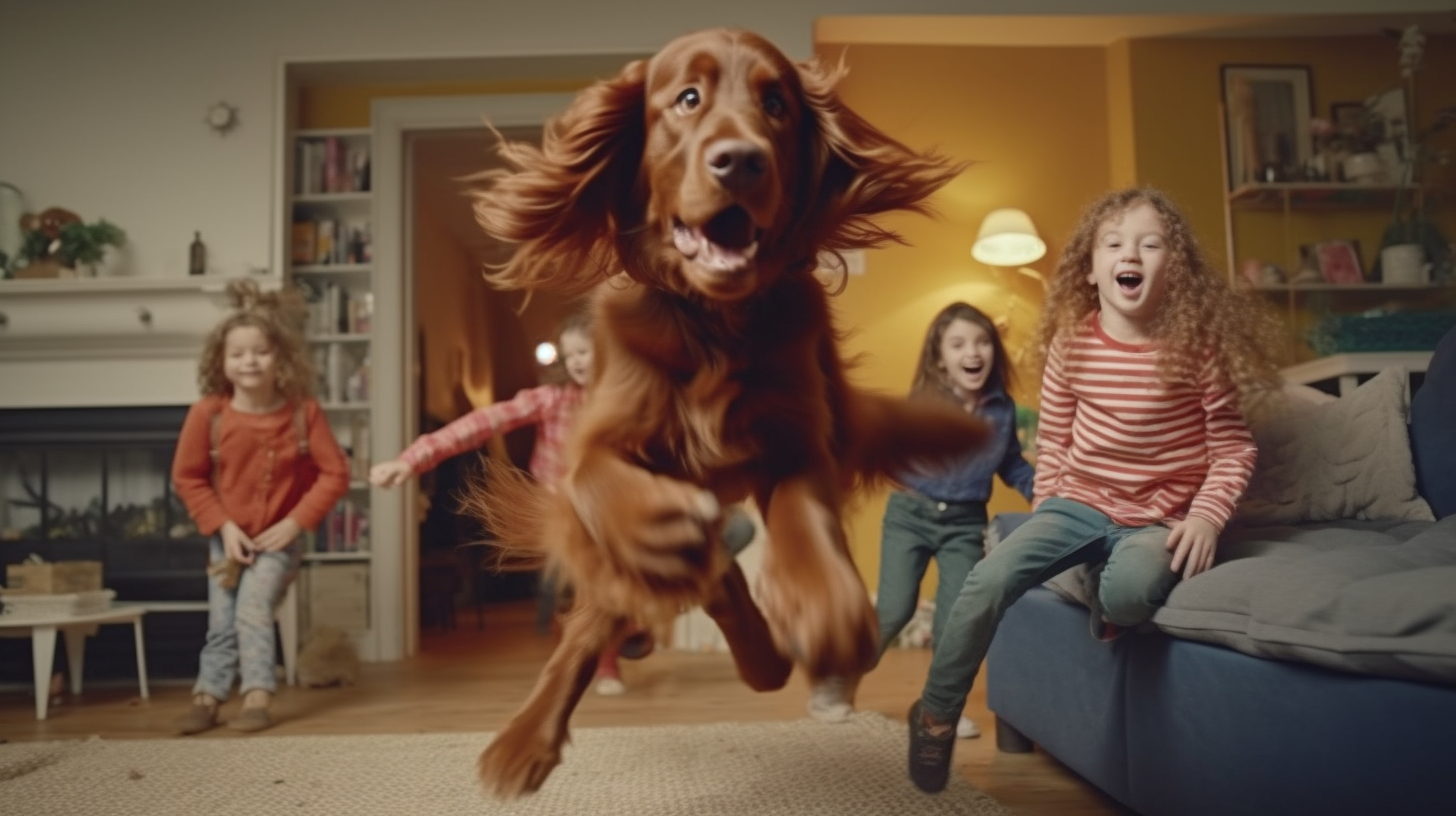
Irish Setters are captivating with their stunning red coats and athletic build, making them a fantastic choice for families who lead an active lifestyle. These graceful dogs are known for their friendly and outgoing personalities, always eager to play and interact with children. With their boundless energy and love for running, they make excellent companions on walks, hikes, or trips to the park.
As a bonus, their gentle nature means they’re likely to be patient with kids’ antics. Grooming your Irish Setter is essential for maintaining its luxurious coat and overall health. Regular brushing will help prevent tangles and matting while also keeping shedding under control. It’s important to pay attention to the ears as well, cleaning them regularly to avoid infection.
Although Irish Setters have some health concerns such as hip dysplasia and progressive retinal atrophy (PRA), regular check-ups with your veterinarian can help keep them in tip-top shape. Before you adopt an Irish Setter, ensure that your family can meet its exercise requirements; these energetic dogs need plenty of daily physical activity to stay happy and healthy.
Adequate space for playtime is also crucial since they enjoy romping around in a fenced yard or open area where they can stretch those long legs fully. By providing proper care, exercise, and grooming along with lots of love from your family members – both young and old – you’ll find that an Irish Setter makes a wonderful addition to any household!
Up next, learn about another great breed perfect for families – the French Bulldog!
French Bulldog

If you’re seeking a low-maintenance, quiet companion that’s perfect for city living, look no further than the French Bulldog – as they say, ‘good things come in small packages.’ This adorable breed is often compared to other small breeds like Pugs and Boston Terriers but stands out with its distinctive bat-like ears and muscular build.
But is the French Bulldog a perfect family pet? The answer is yes! They’re known for their affectionate nature, adaptability to various living situations, and ability to bond well with children.
However, it’s essential to consider French Bulldog health concerns before welcoming one into your home. Like many short-faced breeds, they can be prone to breathing issues and overheating. Regular vet check-ups and monitoring their exercise levels are crucial in maintaining their overall health.
When it comes to training French Bulldogs for kids, consistency and positive reinforcement are key. These intelligent dogs respond well to gentle guidance and will quickly become a beloved member of your family.
French Bulldogs and apartment living go hand-in-hand due to their minimal exercise requirements compared to larger breeds. A few short walks per day should suffice for this compact canine companion.
While there are many similarities between French Bulldogs and other small breeds such as the Pug or Boston Terrier, when it comes down to choosing which suits your family best, remember each breed has its unique traits that may suit your lifestyle better.
So if a loyal, quiet companion who loves cuddles is what you seek for your children – then the charming personality of the French Bulldog might just win your heart over! Up next on our list of family-friendly dog breeds is the Brussels Griffon – another small yet mighty addition worth considering!
Brussels Griffon

Don’t let their small size fool you; Brussels Griffons pack a whole lot of personality and charm, making them an excellent addition to any family. These tiny dogs are known for their distinctive faces and big, expressive eyes that seem to capture every emotion.
Affectionate and sociable, they love being around people and are great with kids who can handle gentle play. Their temperament is generally friendly and curious, which means they’ll be eager to explore the world with you by their side.
Grooming requirements for Brussels Griffons aren’t too demanding, but it’s essential to keep their coats clean and free of tangles. They come in two coat types: smooth and rough. The smooth-coated Griffon needs only weekly brushing while the rough-coated variety may require more frequent grooming sessions to prevent matting.
Training tips for these intelligent little dogs include using positive reinforcement techniques like praise, treats, or toys as rewards for good behavior. Consistency is key when training a Brussels Griffon since they can be quite stubborn at times!
As for exercise needs, despite their small stature, these pups still need daily walks or playtime in a securely fenced area where they can stretch their legs.
When it comes to living arrangements, Brussels Griffons can adapt well to various environments such as apartments or houses with yards. However, they don’t do well in extreme temperatures due to their short snouts so make sure your home is comfortable all year round.
Keep in mind that this breed may not be suitable if you have very young children or larger pets at home because of its delicate frame – but older kids will surely appreciate having this adorable canine companion!
Up next on our list of family-friendly breeds is the Newfoundland – another gentle giant that’s perfect for families seeking a loyal and loving pet friend.
Newfoundland
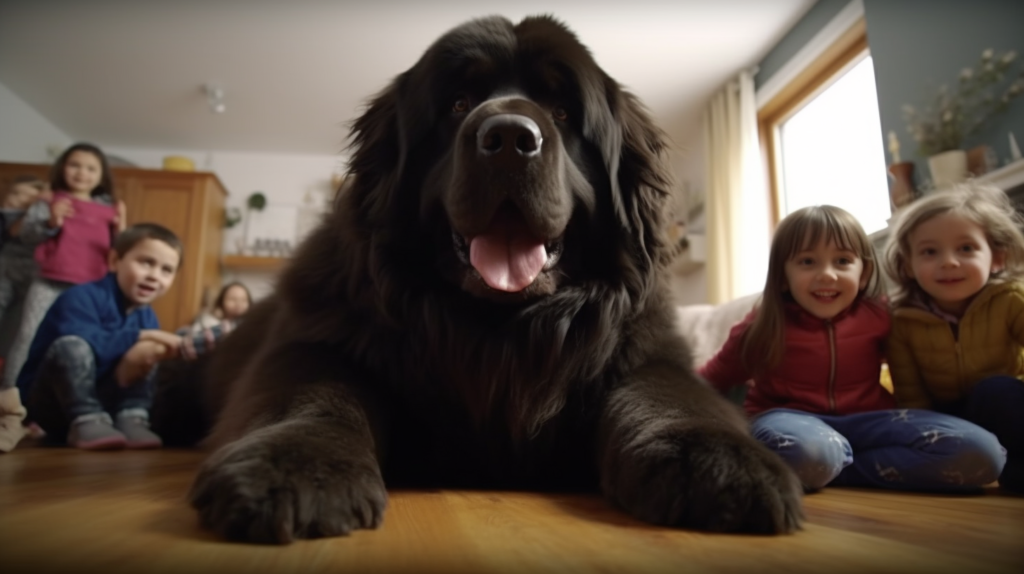
After learning about the charming Brussels Griffon, let’s dive into the world of another wonderful breed for families with kids: the Newfoundland. Affectionately known as a ‘swimming giant,’ this gentle and patient dog is perfect for households that appreciate an oversized yet loving companion.
Although they may be large, their family-friendly temperament makes them worth considering when searching for your next furry friend. One thing to keep in mind when adopting a Newfoundland is their grooming needs. Due to their thick double coat, regular brushing is essential to keep it healthy and tangle-free. In addition, these dogs love water, so don’t be surprised if you find them splashing around during outdoor playtime!
Training tips for Newfoundlands include positive reinforcement techniques and early socialization to ensure they develop good manners. Exercise requirements are moderate; daily walks or swims will help maintain their physical health and happiness.
As you continue exploring dog breeds suitable for families with kids, remember that each one offers unique qualities that can make them an ideal match depending on your lifestyle and preferences. The Newfoundland’s watchful nature combined with its love for children make it a fantastic option worth considering.
Next up on our list of family-friendly dogs is the intelligent and loyal Collie – a breed that will surely captivate your heart with its devotion towards its human companions.
Collie
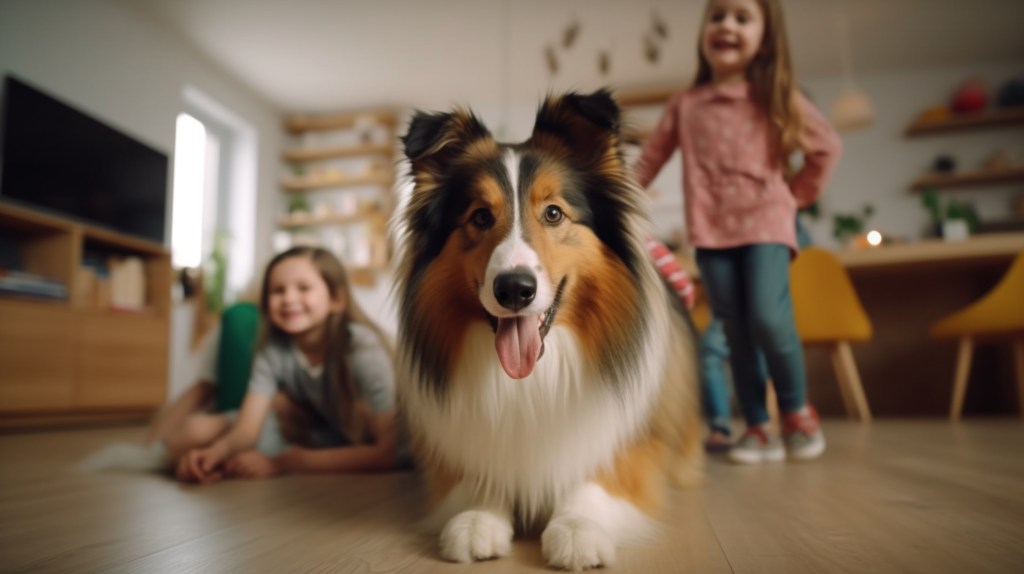
You might think you’re adopting a Collie for your children, but it’s more likely that this intelligent and loyal breed will end up adopting the entire family as its personal herd.
With their warm personality traits, Collies are known to adore children and make great family pets. They come in both rough and smooth varieties, so you can choose the coat type that best suits your lifestyle. However, regardless of which variety you choose, regular Collie grooming is essential to keep their luxurious coats healthy and tangle-free.
Collie training tips often emphasize consistency and positive reinforcement as these dogs are sensitive and eager to please. Their high intelligence means they excel at learning new commands but also require mental stimulation to keep them happy.
When it comes to Collie exercise needs, they have moderate energy levels that can be satisfied with daily walks and playtime in a fenced yard or park. Keep in mind that some Collies may have herding instincts that could lead them to chase after smaller pets or even nip at heels – proper training should help curb this behavior.
Though generally healthy dogs, Collies do have some potential health concerns worth noting, such as eye issues like progressive retinal atrophy (PRA) or collie eye anomaly (CEA). Regular check-ups with your vet can aid in early detection of any issues that may arise down the line.
By providing consistent training, proper grooming practices, ample exercise opportunities, and vigilant attention to potential health risks, you’ll create a loving environment where your intelligent Collie thrives alongside your family.
Up next on our list of family-friendly dog breeds is the soft coated wheaten terrier – another excellent choice for households looking for an active yet loving companion.
Soft-Coated Wheaten Terrier
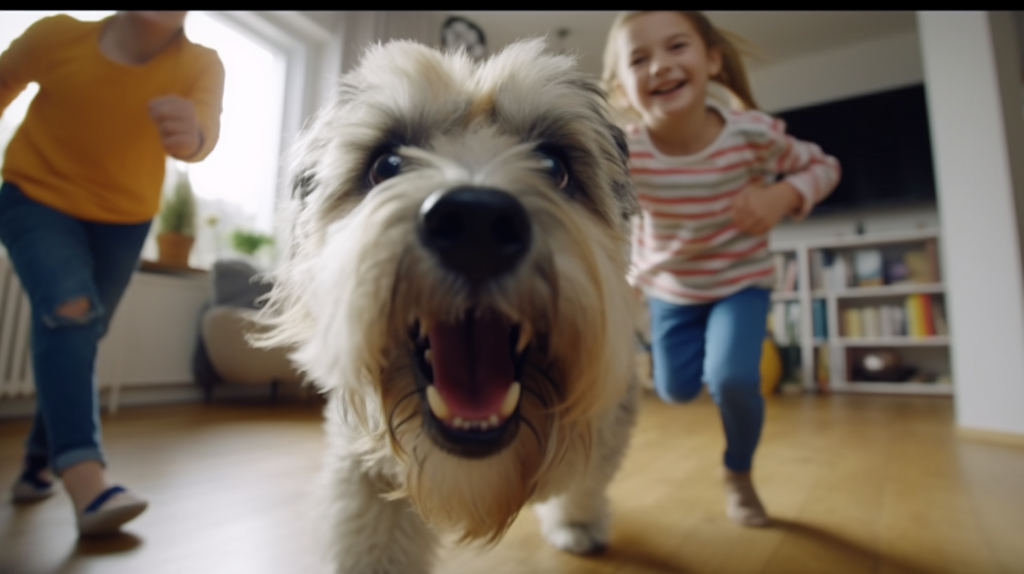
If you’re seeking an energetic and loving companion that’s also hypoallergenic, the Soft Coated Wheaten Terrier might just be the perfect addition to your family. These dogs are known for their happy-go-lucky attitude and affectionate nature, making them great playmates for kids.
They are friendly with everyone they meet, including strangers, so you can feel comfortable bringing them along on family outings or having guests over at your home.
Grooming requirements for Soft Coated Wheaten Terriers include regular brushing to prevent matting and tangles in their soft, wavy coat. Health issues to watch out for in this breed include hip dysplasia, eye disorders, and allergies; however, with proper care and regular vet check-ups, these dogs can live long and healthy lives.
When it comes to exercise needs, they require daily walks and active playtime to keep both their minds and bodies engaged. Training tips for this intelligent breed involve using positive reinforcement techniques like treats or praise – remember that patience is key when teaching your new furry friend new skills.
As you consider adding a Soft Coated Wheaten Terrier to your household, keep in mind their temperament around strangers as well as the grooming requirements necessary to maintain their beautiful coats. With consistent training and ample exercise opportunities provided by an active lifestyle with kids who love playtime outdoors, these dogs thrive in a loving environment where everyone pitches in with care responsibilities.
As you explore various breeds suited for families with children, don’t forget about the versatile Poodle – another excellent option that comes in three sizes while offering both charm and intelligence!
Poodle
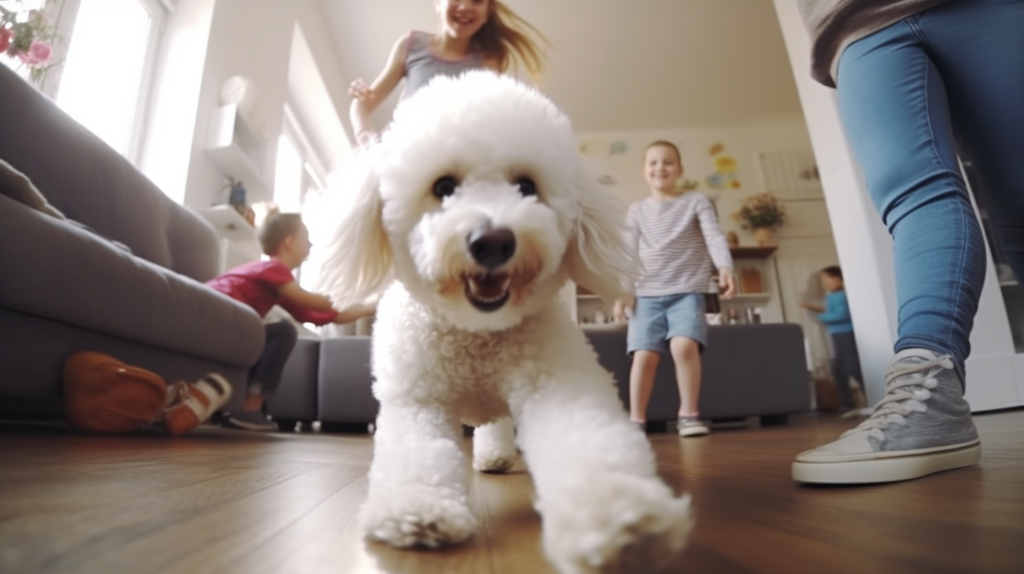
When considering a family-friendly pup, don’t overlook the charming and intelligent Poodle, which comes in three versatile sizes to suit your household’s needs.
Toy, Miniature, and Standard Poodles all exhibit an affectionate and playful nature that makes them excellent companions for children. These highly trainable dogs are eager to please and can adapt well to various home environments, making them ideal for families with different lifestyles.
Grooming tips for Poodles include regular brushing to prevent matting of their curly coat, as well as professional grooming every 4-6 weeks.
Exercise requirements vary depending on the size of the Poodle; while smaller sizes may be content with daily walks and indoor playtime, larger Standard Poodles will benefit from more extensive physical activities such as running or swimming.
Health concerns in this breed include hip dysplasia, progressive retinal atrophy (PRA), and bloat; so it’s essential to schedule regular veterinary checkups.
Training techniques should focus on positive reinforcement methods since this sensitive breed responds best to encouragement and praise.
As you continue researching family-friendly dog breeds for your kids, consider the Bichon Frise – another amiable small breed that boasts friendliness towards everyone they meet.
Their hypoallergenic coat and loving nature make them a popular choice among families seeking a loyal companion that can easily fit into their homes and hearts.
Bichon Frise

After considering the delightful Poodle, you might also want to look into the charming Bichon Frise. This amiable breed operates under the assumption that there are no strangers, just friends they haven’t met yet. Their cheerful disposition and small size make them an excellent choice for families with kids. They are known for their fluffy white coats and teddy bear-like appearance, which is sure to win over everyone in your household.
Bichon Frises have a few specific needs you’ll want to be aware of:
- Grooming tips: Their beautiful coat requires regular grooming to prevent matting and maintain its gorgeous appearance. Brushing at least twice a week and scheduling professional grooming every four to six weeks is recommended.
- Training techniques: These intelligent dogs respond well to positive reinforcement training methods like praise, treats, and toys as rewards. Consistency is key when teaching your Bichon new commands or tricks.
- Temperament analysis: Bichons are generally friendly and social by nature, but early socialization with people and other animals is essential for ensuring that they grow up confident and well-adjusted.
When it comes to exercise needs, Bichon Frises do not require extensive physical activity like larger breeds do; however, daily walks or playtime in a fenced-in area will keep them happy and healthy. Some potential health concerns include allergies, dental issues, hip dysplasia, bladder stones, cataracts—regular check-ups with your veterinarian can help detect any problems early on.
As you’re exploring dog breeds suitable for your family’s lifestyle, don’t forget about the unique Vizsla—one more fantastic option worth considering!
Vizsla

You’ll certainly be intrigued by the Vizsla, a unique sporting dog that thrives on exercise and has a sensitive, affectionate nature. This breed is perfect for active families who enjoy spending time outdoors and participating in various physical activities together.
Training tips for this intelligent dog include using positive reinforcement techniques and maintaining consistency, as they’re eager to please their humans. When it comes to exercise needs, these dogs require daily walks or runs to keep them healthy and happy.
Health concerns for the Vizsla include hip dysplasia, eye disorders, and epilepsy. It’s essential to work with a reputable breeder or rescue organization to ensure you’re adopting a healthy dog. Regular check-ups with your veterinarian will help detect and address any potential health issues early on.
Grooming requirements for this breed are relatively low-maintenance; their short coat needs occasional brushing to remove dead hair and maintain its shine.
Temperament-wise, Vizslas are known for being gentle, loving companions that get along well with children of all ages. They thrive on human interaction and form strong bonds with their family members. However, due to their high energy levels and exercise needs, they may not be suitable for every household or lifestyle. If your family is ready to embrace an energetic companion that loves outdoor adventures alongside plenty of snuggles at home after an active day out together – then the Cocker Spaniel might just be what you’re looking for!
Cocker Spaniel
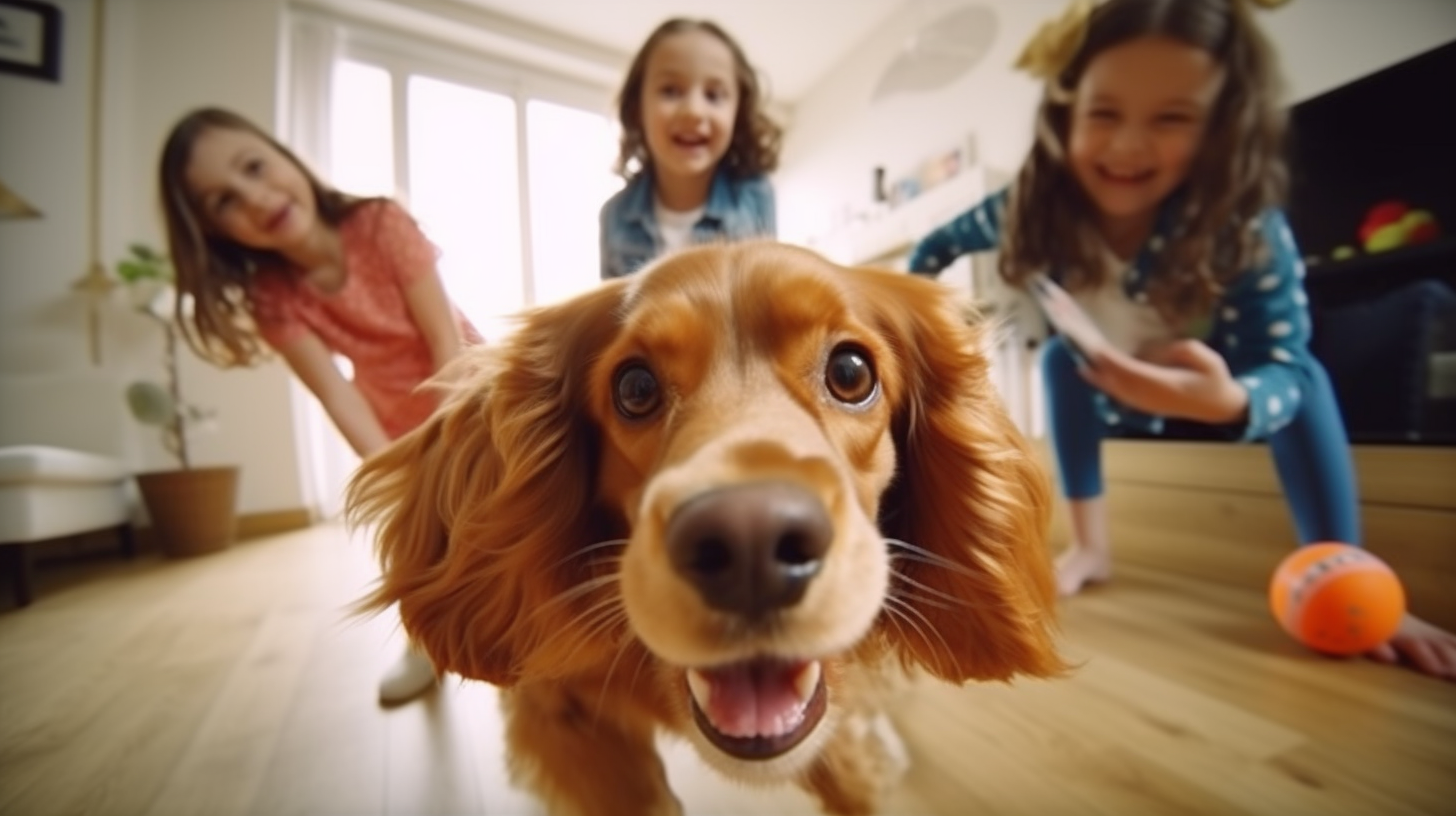
Cocker Spaniels, the smallest members of the sporting group, are known for their soft ears and sweet expressions, making them an irresistible choice for many families. In fact, around 44% of households in the US own at least one dog, with Cocker Spaniels ranking among the top favorites. These delightful dogs can bring joy to your home and become a loving companion for your kids.
Pros and Cons: Cocker Spaniels are friendly, affectionate dogs that bond well with children. They’re intelligent and eager to please, which makes training relatively easy. However, they do have some potential downsides to consider. Their long coats require regular grooming to prevent matting and tangles; additionally, they’re prone to certain health concerns such as ear infections or hip dysplasia.
Grooming Needs: As mentioned above, this breed has high grooming needs due to their long coat. Regular brushing is essential to keep it clean and tangle-free; you may also need to trim or clip their fur periodically.
Exercise Requirements: Despite being small in size, Cocker Spaniels still need daily physical activity like walks or playtime in a fenced yard.
When it comes to training tips for your Cocker Spaniel, remember that consistency is key – stick with positive reinforcement methods like praise and treats when they follow commands correctly. Be patient during training sessions since these dogs can be sensitive and may not respond well if you get frustrated with them easily. Last but not least, always keep an eye on any potential health concerns like ear infections or hip dysplasia by scheduling regular check-ups with your veterinarian so that any issues can be addressed promptly before they worsen over time.
As you can see from this information on Cocker Spaniels’ pros and cons as family pets – alongside considerations about grooming needs – these charming pups make great companions for children who understand how to treat them gently and with respect. By providing proper exercise, training, and care, you can ensure a happy, healthy life for your Cocker Spaniel as they become an integral member of your family dedicated to serving others in their own unique way.
Frequently Asked Questions
How do I determine which dog breed is best suited for my child’s personality and energy level?
Consider your child’s temperament, energy compatibility, and the dog breed’s size and training needs. Conduct thorough breed research to understand their traits and discuss with shelter or rescue staff for guidance.
Are there any specific dog breeds that are recommended for families with children who have allergies?
Consider hypoallergenic breeds like Poodle mixes for allergy-friendly dogs. Low shedding options can reduce allergens at home. Consult with a veterinarian about allergy testing to ensure the best fit for your family.
How can I prepare my home and family for the arrival of a new dog to ensure a smooth transition for both the dog and the kids?
To prepare for your new dog, make home adjustments like dog-proofing and establishing boundaries. Create family routines for walking and feeding, and practice introducing pets gently to ensure a smooth transition for everyone.
What are some tips for teaching children how to properly interact with and care for a new dog in the family?
Did you know 67% of US households have pets? Teach kids proper dog interaction using positive reinforcement, training teamwork, setting boundaries, and establishing routines for child-dog play. Happy tails start with a loving home!
How can I involve my children in the dog adoption process to ensure they understand the responsibilities and commitment involved in pet ownership?
Involve your children in adoption education, prioritizing safety and discussing long-term commitment. Encourage age-appropriate tasks during the process. Parental involvement ensures kids understand pet ownership responsibilities and fosters a loving bond.
Conclusion
So, don’t hesitate to hop in the Mystery Machine and embark on a journey to find the perfect furry companion for your kids.
With countless breeds available, there’s a dog out there that’ll fit like a glove in your family. From the spirited Boxer to the loving Bichon Frise, there are plenty of options.
Just remember: whether you’re adopting an older dog or training a new pup, patience and positivity are key ingredients to ensure that your children and their canine buddy enjoy years of tail-wagging fun together.
